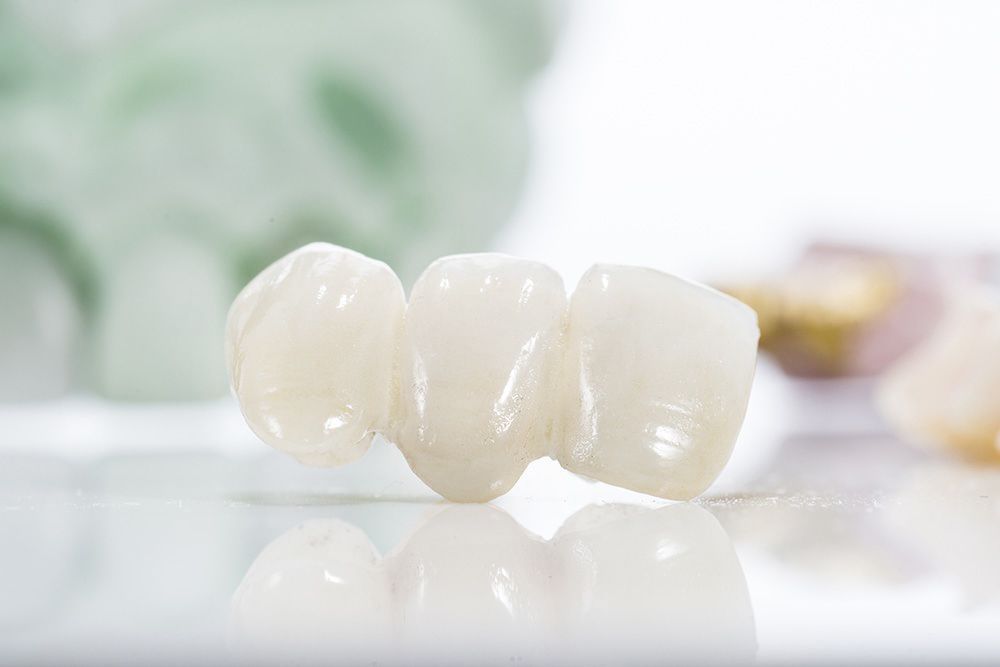Types of Dental Bridges
There are several types of dental bridges available to replace missing teeth. Traditional bridges are supported by two crowns on either side of the gap in a patient’s smile. Typically, these crowns are supported by adjacent healthy teeth. To place this type of restoration, the dentist will need to reshape these teeth to make room for the bridge. In the last 20 years, implant-supported bridges have become increasingly popular. These bridges also rest on two crowns, but the crowns are affixed to surgically placed implant posts, rather than the nearby teeth. Using this type of restoration, a dentist can preserve more of a patient’s natural tooth structure.
Dental Bridge
Cantilever Bridges
To place a cantilever bridge, the dentist will only crown one adjacent tooth. This single crown will support the entire restoration, which typically consists of two pontics. Dentists do not typically recommend cantilever bridges on back teeth. The molars bear most of the force of a patient’s bite. Therefore, a cantilever bridge in this area would be subject to damage and even collapse. Cantilever bridges have largely fallen out of use. However, in some cases, they can still be an excellent option, since they will preserve more of a patient’s healthy tooth structure.
Maryland Bonded Bridges
The Maryland bonded bridge, developed by researchers at the University of Maryland, involves minimal alteration of the surrounding teeth. Instead, the pontic will have two small wings, which will attach to the adjacent teeth. To place this type of bridge, the dentist will simply need to micro-etch the two supporting teeth to create a stronger bond for the restoration. In the past, the wings were always made of metal, which could eventually lend a gray tint to a patient’s smile. Today, however, Maryland bonded bridges are made with resin wings. These pieces can be custom-matched to the blend with the color of the nearby teeth. Typically, dentists will use a Maryland bonded bridge to replace a single missing tooth. In some cases, however, these bridges can replace two or three teeth.
Removable Bridges
Although most bridges are permanently fixed in a patient’s mouth, some people may benefit from a removable bridge, sometimes called a “partial denture.” Like traditional bridges, removable restorations are custom crafted to match a patient’s natural teeth. However, they have a gum colored plastic base and attach to the surrounding teeth with small metal clasps or precision attachments. Removable bridges typically cost less than crown or implant-supported restorations. Nevertheless, they do not offer the same stability or lifelike feel that a fixed bridge can provide.
Crown-Supported Bridges
When someone mentions a “dental bridge,” most people will immediately think of traditional, crown-supported bridges. These crowns are placed directly on top of a damaged tooth. Therefore the dentist must reshape these teeth to make room for the bridge and create a stable base for the new restoration. One to three pontics attach to the crowns, filling in the gap in a patient’s smile.
Advantages and Disadvantages of Traditional Bridges
The most significant benefit of crown-supported bridges is that the process is quick and easy. It does not involve lengthy treatment. Typically, after just two office visits, patients leave the office with full dental functionality. However, patients should be aware that the crowning procedure will slightly weaken the teeth supporting the restoration. In addition, unlike an implant-supported bridge, a crown-supported restoration will not prevent jawbone degeneration.
Implant-Supported Bridges
The most common alternative to a traditional crown-supported bridge is an implant-supported bridge. A dental implant is a titanium post placed directly into the jawbone. Using an abutment piece, a dentist can secure a custom-fabricated restoration directly to the implant post. In effect, the implant will becomes a new tooth root, allowing for a durable, long-lasting restoration. In fact, with proper care, dental implants can last for decades or more.
/http://d3b3by4navws1f.cloudfront.net/traditionalbridge-vs-implant.jpg)
Advantages and Disadvantages of Implant-Supported Restorations
Implant placement requires oral surgery. Therefore, patients will face a longer recovery and more post-treatment sensitivity. They may also require additional preparatory treatment, such as a bone graft, to qualify for an implant-supported restoration. Patients should also note that dental implants cost more than traditional bridges.
Despite these initial drawbacks, dental implants offer numerous long-term advantages. In fact, most experts consider implants to be the top method of tooth replacement. They are extremely stable and will never slip out of place. Although they do have higher upfront costs, implants can last a lifetime. Therefore, patients typically do not have to worry about expensive replacements later down the road. Finally, dental implants are the only type of restorative treatment that can prevent jawbone degeneration. The titanium posts replace dental roots, giving off the signals that are necessary for re-mineralization.



